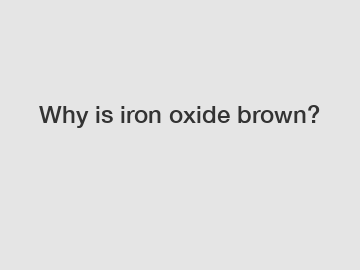Why is iron oxide brown?
Why is Iron Oxide Brown?
Iron oxide is a widely recognized compound that exhibits a distinctive brown color. This article aims to explore the reasons behind the brown coloration of iron oxide. By delving into the chemical composition and structure of iron oxide, as well as the properties it exhibits, we can gain a better understanding of why this compound appears brown.
Chemical Composition.

Iron oxide, also known as ferric oxide or rust, is formed when iron reacts with oxygen in the presence of water or moisture. Its chemical formula is Fe2O3, indicating that it consists of two atoms of iron (Fe) and three atoms of oxygen (O). The bonding between iron and oxygen atoms leads to the structure of iron oxide, which plays a key role in its coloration.
Crystal Structure.
Iron oxide possesses a crystal structure known as hematite. Hematite is characterized by a trigonal lattice arrangement, where the iron and oxygen atoms are positioned in a specific pattern. The arrangement of atoms affects the way light interacts with the compound, ultimately influencing its color.
Light Absorption.
The brown color of iron oxide is a result of its ability to absorb certain wavelengths of light. When light interacts with a substance, some of it is absorbed, some is transmitted through, and the rest is reflected. In the case of iron oxide, it absorbs light in the blue and green regions of the visible spectrum, while reflecting light in the red and brown regions. This selective absorption and reflection of light determine the overall color perceived by our eyes.
Electronic Transitions.
The absorption of specific wavelengths of light by iron oxide is linked to the electronic transitions that occur within its crystal structure. When light strikes the compound, it energizes the electrons in the iron and oxygen atoms, causing them to move to higher energy levels. This energy absorption and subsequent release manifest as the absorption and reflection of specific colors.
Hematite Absorption Spectrum.
Hematite, the crystal structure of iron oxide, displays a distinct absorption spectrum. It absorbs light in the ultraviolet (UV) region and extends into the visible spectrum. The wavelengths of light that correspond to absorption peaks in the blue and green regions are responsible for the brown coloration observed in iron oxide.
Factors Affecting Color.
While the chemical composition and crystal structure primarily contribute to the brown color of iron oxide, external factors may also influence its appearance. These factors include particle size, impurities, and environmental conditions. Finely divided iron oxide particles tend to scatter light more effectively, resulting in a more opaque appearance and a darker brown color.
Conclusion.
In conclusion, the brown color of iron oxide can be attributed to its chemical composition, crystal structure, and electron transitions within its lattice arrangement. The selective absorption and reflection of light specifically in the blue and green regions of the visible spectrum lead to the perception of brown color. Additionally, factors such as particle size and impurities can modify the intensity of the brown shade. Understanding the science behind the brown coloration of iron oxide enhances our knowledge of this compound's properties and applications.
If you have any further questions or would like to learn more about iron oxide and its properties, please do not hesitate to contact us.
Are you interested in learning more about sillimanite powder manufacturer, oxide pigment powder manufacturer, Calcined Petroleum Coke Particles? Contact us today to secure an expert consultation!


